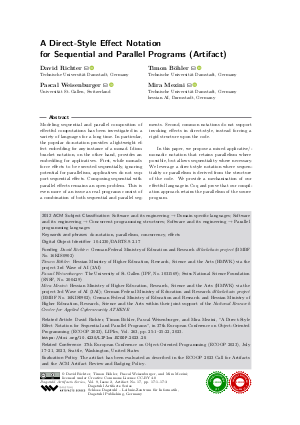A Direct-Style Effect Notation for Sequential and Parallel Programs (Artifact)
Authors
David Richter  ,
Timon Böhler
,
Timon Böhler  ,
Pascal Weisenburger
,
Pascal Weisenburger  ,
Mira Mezini
,
Mira Mezini 
-
Part of:
Issue:
Special Issue of the 37th European Conference on Object-Oriented Programming (ECOOP 2023)
Part of: Volume: DARTS, Volume 9 (ECOOP 2023)
Part of: Conference: European Conference on Object-Oriented Programming (ECOOP)
Part of: Journal: Dagstuhl Artifacts Series (DARTS) - License:
 Creative Commons Attribution 4.0 International license
Creative Commons Attribution 4.0 International license
- Publication Date: 2023-07-11
Artifact Description

PDF
DARTS.9.2.17.pdf
- Filesize: 499 kB
- 3 pages
Document Identifiers
Subject Classification
ACM Subject Classification
- Software and its engineering → Domain specific languages
- Software and its engineering → Concurrent programming structures
- Software and its engineering → Parallel programming languages
Keywords
- do-notation
- parallelism
- concurrency
- effects
Metrics
- Access Statistics
-
Total Accesses (updated on a weekly basis)
0PDF Downloads0Metadata Views
Abstract
Modeling sequential and parallel composition of effectful computations has been investigated in a variety of languages for a long time. In particular, the popular do-notation provides a lightweight effect embedding for any instance of a monad. Idiom bracket notation, on the other hand, provides an embedding for applicatives. First, while monads force effects to be executed sequentially, ignoring potential for parallelism, applicatives do not support sequential effects. Composing sequential with parallel effects remains an open problem. This is even more of an issue as real programs consist of a combination of both sequential and parallel segments. Second, common notations do not support invoking effects in direct-style, instead forcing a rigid structure upon the code. In this paper, we propose a mixed applicative/monadic notation that retains parallelism where possible, but allows sequentiality where necessary. We leverage a direct-style notation where sequentiality or parallelism is derived from the structure of the code. We provide a mechanisation of our effectful language in Coq and prove that our compilation approach retains the parallelism of the source program.
Cite As Get BibTex
David Richter, Timon Böhler, Pascal Weisenburger, and Mira Mezini. A Direct-Style Effect Notation for Sequential and Parallel Programs (Artifact). In Special Issue of the 37th European Conference on Object-Oriented Programming (ECOOP 2023). Dagstuhl Artifacts Series (DARTS), Volume 9, Issue 2, pp. 17:1-17:3, Schloss Dagstuhl – Leibniz-Zentrum für Informatik (2023)
https://doi.org/10.4230/DARTS.9.2.17
BibTex
@Article{richter_et_al:DARTS.9.2.17,
author = {Richter, David and B\"{o}hler, Timon and Weisenburger, Pascal and Mezini, Mira},
title = {{A Direct-Style Effect Notation for Sequential and Parallel Programs (Artifact)}},
pages = {17:1--17:3},
journal = {Dagstuhl Artifacts Series},
ISSN = {2509-8195},
year = {2023},
volume = {9},
number = {2},
editor = {Richter, David and B\"{o}hler, Timon and Weisenburger, Pascal and Mezini, Mira},
publisher = {Schloss Dagstuhl -- Leibniz-Zentrum f{\"u}r Informatik},
address = {Dagstuhl, Germany},
URL = {https://drops.dagstuhl.de/entities/document/10.4230/DARTS.9.2.17},
URN = {urn:nbn:de:0030-drops-182573},
doi = {10.4230/DARTS.9.2.17},
annote = {Keywords: do-notation, parallelism, concurrency, effects}
}
Author Details
Funding
- Richter, David: German Federal Ministry of Education and Research iBlockchain project (BMBF No. 16KIS0902)
- Böhler, Timon: Hessian Ministry of Higher Education, Research, Science and the Arts (HMWK) via the project 3rd Wave of AI (3AI)
- Weisenburger, Pascal: The University of St. Gallen (IPF, No. 1031569); Swiss National Science Foundation (SNSF, No. 200429)
- Mezini, Mira: Hessian Ministry of Higher Education, Research, Science and the Arts (HMWK) via the project 3rd Wave of AI (3AI); German Federal Ministry of Education and Research iBlockchain project (BMBF No. 16KIS0902); German Federal Ministry of Education and Research and Hessian Ministry of Higher Education, Research, Science and the Arts within their joint support of the National Research Center for Applied Cybersecurity ATHENE
Artifact
DARTS-9-2-17-artifact-4a0db8605896be17ef789fc3bc4b7f59.tar.gz
(Filesize: 0.94 GB)
MD5 Sum:
4a0db8605896be17ef789fc3bc4b7f59
(Get MD5 Sum)
Artifact Evaluation Policy
The artifact has been evaluated as described in the ECOOP 2023 Call for Artifacts and the ACM Artifact Review and Badging Policy
Related Article
- David Richter, Timon Böhler, Pascal Weisenburger, and Mira Mezini, "A Direct-Style Effect Notation for Sequential and Parallel Programs", in 37th European Conference on Object-Oriented Programming (ECOOP 2023), LIPIcs, Vol. 263, pp. 25:1-25:22, 2023. https://doi.org/10.4230/LIPIcs.ECOOP.2023.25
